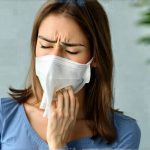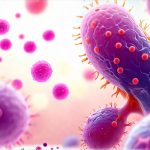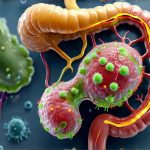Viral infections, whether it’s the seasonal flu or the more recently understood COVID-19, don’t just attack our respiratory systems – they fundamentally alter the intricate ecosystem within us known as the microbiome. This often-overlooked community of bacteria, fungi, viruses, and other microorganisms residing in our gut (and elsewhere) plays a critical role not only in maintaining overall health but also in modulating our immune responses. When we fall ill with a virus, this delicate balance is disrupted, leading to changes that can affect the severity of the illness itself and how quickly and effectively we recover. Understanding this complex interplay is becoming increasingly important for developing more holistic strategies for both preventing and recovering from viral infections.
The disruption caused by a viral infection isn’t merely collateral damage; it’s an active component of the immune response, but also one that can contribute to prolonged symptoms or even post-viral complications. The microbiome acts as a key trainer for our immune system, helping it distinguish between friend and foe. A healthy, diverse microbiome prepares the immune system to respond appropriately to pathogens. However, viral infections, along with associated factors like stress and antibiotic use (often prescribed during secondary bacterial infections), can dramatically reduce microbial diversity, impair immune function, and even create opportunities for harmful bacteria to flourish. This leads to a vicious cycle where an impaired microbiome hinders recovery, potentially prolonging the effects of the initial infection and increasing susceptibility to future illnesses. For those struggling with these aftereffects, building a recovery plan can be incredibly helpful.
The Gut-Immune Axis And Viral Infections
The gut-immune axis is arguably the most crucial connection in understanding how our microbial communities impact viral infections and subsequent recovery. It’s a bidirectional communication network – meaning information flows both ways between the gut microbiome and the immune system. A significant portion of our immune cells (around 70-80%) reside in the gut, constantly interacting with microbes and learning to respond appropriately. The microbiome influences immune cell development, activation, and regulation. Specific microbial metabolites, like short-chain fatty acids (SCFAs) produced during fiber fermentation, are vital for maintaining gut barrier integrity and modulating inflammation.
When a virus enters the body, it doesn’t just stay confined to the respiratory tract. Immune responses triggered by the infection can significantly impact the gut microbiome. Inflammatory molecules released as part of the immune response – cytokines like TNF-alpha and interferon gamma – can alter microbial composition, favoring certain species over others. This disruption often leads to a reduction in beneficial bacteria (like Bifidobacterium and Lactobacillus) and an increase in potentially harmful ones. Furthermore, viral infections themselves can directly affect gut barrier function, increasing intestinal permeability (“leaky gut”) allowing bacterial products to enter the bloodstream and further exacerbating inflammation.
This altered microbiome then provides a less effective training ground for the immune system. The reduction in SCFA production weakens the gut barrier, making it more vulnerable to future disruptions. It also impacts the ability of immune cells to function optimally, hindering their capacity to clear remaining viral particles or respond effectively to secondary infections. Essentially, a compromised microbiome makes it harder for the body to return to its baseline state of immune readiness after the initial infection has subsided. Restoring microbial diversity and functionality is therefore paramount in supporting effective recovery. Digestive recovery often focuses on rebuilding this balance.
Microbial Metabolites And Immune Modulation
Microbial metabolites aren’t just passive byproducts of bacterial activity; they are active signaling molecules that directly impact immune function. SCFAs, mentioned earlier, are prime examples. These compounds, produced from the fermentation of dietary fiber, have a wide range of immunomodulatory effects:
- They enhance gut barrier integrity, reducing inflammation and preventing “leaky gut”.
- They promote the development of regulatory T cells (Tregs), which help to suppress excessive immune responses and prevent autoimmunity.
- They influence the function of macrophages and dendritic cells, key players in antigen presentation and immune cell activation.
Beyond SCFAs, other microbial metabolites like tryptophan derivatives and bile acid metabolites also play important roles in shaping the immune response. A diverse microbiome produces a wider range of these beneficial compounds, providing more robust support for immune regulation. Viral infections can deplete or alter the production of these vital metabolites, further compromising immune function and delaying recovery. Strategies aimed at supporting microbial metabolite production – primarily through dietary interventions – are therefore crucial for optimizing immune responses during and after viral infections. Understanding acid buildup can also help manage related symptoms.
Dietary Interventions For Microbiome Support
Diet plays a pivotal role in shaping both the composition and functionality of the microbiome. During and after a viral infection, strategic dietary choices can help to restore microbial balance and support immune recovery. Here’s how:
- Increase Fiber Intake: Fiber is the primary food source for beneficial gut bacteria, promoting the production of SCFAs. Focus on incorporating diverse sources of fiber from fruits, vegetables, whole grains, legumes, and nuts/seeds.
- Include Fermented Foods: Foods like yogurt (with live cultures), kefir, sauerkraut, kimchi, and kombucha contain probiotics – live microorganisms that can contribute to microbial diversity. However, it’s important to note that probiotic effects are strain-specific, and the benefits of fermented foods extend beyond just probiotic content, providing diverse substrates for gut bacteria.
- Reduce Processed Foods, Sugar, And Artificial Sweeteners: These components can negatively impact the microbiome, promoting the growth of harmful bacteria and reducing microbial diversity. They also contribute to inflammation which further hinders recovery.
- Consider Prebiotics: Prebiotics are non-digestible fibers that selectively promote the growth of beneficial bacteria. Sources include onions, garlic, leeks, asparagus, bananas, and oats.
It’s important to note that dietary interventions should be individualized based on tolerance and existing health conditions. Sudden drastic changes in diet can sometimes exacerbate symptoms. A gradual approach is often more effective. If you experience issues after overeating, managing indigestion may provide relief.
The Role Of Post-Viral Syndromes And Long COVID
The link between microbiome disruption and prolonged post-viral syndromes, such as “Long COVID,” is gaining increasing attention. Many individuals experiencing long-term symptoms after a viral infection report persistent gut issues, fatigue, brain fog, and immune dysfunction – all of which can be linked to alterations in the microbiome. The chronic inflammation associated with ongoing microbial imbalance may contribute to these lingering effects.
The exact mechanisms are still being investigated, but it appears that disruptions in the microbiome can lead to:
- Impaired energy metabolism and mitochondrial function, contributing to fatigue.
- Increased intestinal permeability allowing for systemic inflammation and neuroinflammation (impacting brain function).
- Dysregulation of the immune system leading to chronic activation or suppression.
Addressing the microbiome through dietary interventions, targeted supplementation (under professional guidance), and stress management may offer a promising avenue for mitigating these post-viral symptoms. Research is ongoing to identify specific microbial signatures associated with Long COVID and develop personalized strategies for restoring microbial balance and supporting recovery. The understanding that viral infections are not isolated events but leave lasting impacts on our internal ecosystems is reshaping how we approach health and healing. Sometimes, persistent issues may be related to GERD – it’s important to rule out underlying conditions.


















